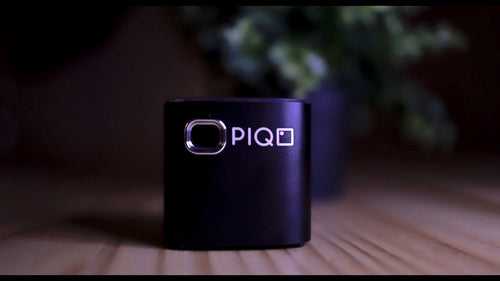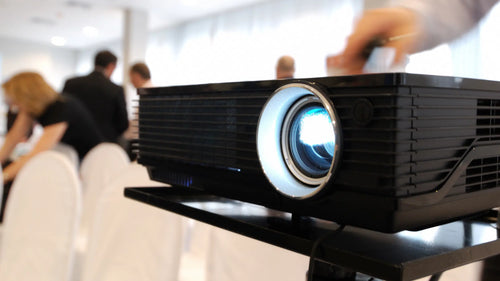Unlock Your Home Theater: Mastering the Art of Hanging a Projector Screen!

When it comes to creating an immersive home theater experience, projectors like PIQO play a crucial role. After all, these devices let you enjoy your favorite movies with a better visual experience.
However, we should never neglect the importance of a projector screen. It serves as the canvas on which your projector projects stunning visuals, allowing you to enjoy a larger-than-life display. Hanging a projector screen may seem like a daunting task, but with the right approach and knowledge, it can be a rewarding and straightforward process.
In this article, we'll guide you through the process, step by step, helping you unlock the full potential of your home theater. Let’s dive in!
Why Hanging a Projector Screen Matters?
Hanging a projector screen correctly is essential to maximize the quality of your projected images. A properly installed screen ensures optimal viewing angles, reduces light reflection, and enhances the overall visual experience. By paying attention to the details, you can transform your room into a dedicated space for entertainment, bringing the magic of the cinema right into your home.
How to Hang an Art Projector Screen?
Let’s explore how to properly hang an art projector screen:
1. Choosing the Right Location
Before you start hanging your projector screen, it's essential to choose the right location within your space. Consider the room layout and the positioning of your seating area. The goal is to find a spot that offers optimal viewing angles for everyone in the room. Take note of any potential obstructions, such as windows, doors, or light fixtures, that could interfere with the projection.
2. Preparing the Mounting Surface
Once you've identified the ideal location, it's time to prepare the mounting surface. Determine whether you'll mount the screen on a wall or from the ceiling. Ensure that the chosen surface is sturdy and capable of supporting the weight of the screen. Additionally, assess the condition of the surface and make any necessary repairs or cleaning before proceeding.
3. Gathering the Necessary Tools and Equipment
Before you begin the installation process, gather all the necessary tools and equipment. These typically include a measuring tape, level, screwdriver or drill, mounting brackets or hooks, screws or anchors, and any additional hardware specific to your chosen mounting option. Having everything ready beforehand will streamline the installation process.
4. Measuring and Marking
Accurate measurements ensure that your projector screen is properly positioned and aligned. Start by determining the desired screen size and aspect ratio based on your viewing preferences and available space.
Mark the position of the top edge of the screen, ensuring it is level and aligned with the surrounding walls or ceiling. Measure and mark the desired height for the screen, considering any furniture or fixtures below.
5. Mounting Options for Projector Screens
Different mounting options are available for projector screens, depending on the screen type and your installation preferences. Let's explore three common methods: installing a fixed-frame projector screen, setting up a motorized projector screen, and installing a manual pull-down projector screen.
Installing a Fixed Frame Projector Screen
A fixed-frame projector screen offers a sleek and permanent solution. Start by assembling the frame according to the manufacturer's instructions. Then, securely attach the screen material to the frame. Finally, mount the frame on the wall, ensuring its level and securely anchored.
Setting Up a Motorized Projector Screen
Motorized projector screens provide convenience and flexibility, allowing you to easily retract or lower the screen. Begin by installing the screen brackets, ensuring they are securely attached to the wall or ceiling. Then, follow the manufacturer's instructions to install the motorized screen and connect it to a power source.
Installing a Manual Pull-Down Projector Screen
Manual pull-down projector screens are popular due to their affordability and ease of use. Mount the screen brackets securely to the wall or ceiling, then attach the screen case. Ensure the screen is level and aligned properly, and test the smooth operation of the pull-down mechanism.
6. Hanging the Projector Screen
With the mounting hardware securely in place, it's time to hang the projector screen. Carefully attach the screen to the mounting brackets or hooks, following the manufacturer's instructions. Ensure that the screen is evenly tensioned and free from wrinkles or folds. Check that the screen is level and centered, making necessary adjustments to achieve the desired positioning.
7. Testing and Adjustments
Once the screen is hung, it's essential to test its operation and make any necessary adjustments. Activate the screen using the control mechanism provided and verify that it rolls up and down smoothly.
If needed, slightly adjust the screen's position slightly to optimize the viewing experience. Take into account the distance between the projector and the screen, ensuring it aligns with the recommended specifications for your projector model.
8. Cable Management
To maintain a clean and organized setup, consider implementing effective cable management strategies. Conceal cables by routing them through walls, cable raceways, or adhesive cable clips. This enhances the visual aesthetics and reduces the risk of tripping hazards. Additionally, ensure that the cables are properly connected between the projector and audiovisual equipment for a seamless experience.
9. Projector Screen Placement Tips
In addition to proper setup, consider the following tips for optimal projector screen placement:
Ambient Light Considerations
Controlling ambient light is crucial for an immersive viewing experience. Minimize light sources or use blackout curtains to eliminate external light interference. Consider using a screen with a higher gain or an ambient light rejection (ALR) screen if your viewing area cannot be completely darkened.
Acoustic Transparency
Opt for an acoustically transparent screen if you have a dedicated home theater or an audio system behind the screen. These screens allow sound to pass through, ensuring that the audio quality remains uncompromised while maintaining a seamless visual display.
Room Layout and Seating Arrangement
Consider the room layout and the seating arrangement when positioning the projector screen. Ensure that all viewers have a comfortable viewing angle without straining their necks. Arrange to sit so that everyone can enjoy an unobstructed view of the screen.
Maintenance and Care for Projector Screens
To ensure your projector screen's longevity and optimal performance, it's important to follow proper maintenance and care guidelines. Consider the following:
1. Cleaning Guidelines
Regularly clean the screen to remove dust, fingerprints, or smudges that may accumulate over time. Use a soft microfiber cloth or a screen-specific cleaning solution to gently wipe the surface. Avoid using abrasive materials or harsh chemicals that can damage the screen.
2. Storage and Protection
If the projector screen is not in use for an extended period, store it properly to avoid damage. Roll up or fold the screen according to the manufacturer's instructions and store it in a protective case or cover. Protect the screen from moisture, extreme temperatures, and physical impact.
3. Screen Repairs and Replacements
If the projector screen gets damaged or develops any issues, consult the manufacturer's guidelines for repair or replacement options. Avoid attempting repairs yourself, as this may void any warranty or further damage the screen. Contact a professional or manufacturer for assistance.
Benefits of Hanging a Projector Screen
Let’s explore the various advantages of incorporating a projector screen into your setup.
1. Enhanced Viewing Experience
Hanging a projector screen enhances the viewing experience in the following ways:
Immerse Yourself in the Big Picture
The primary advantage of a projector screen is the ability to immerse yourself in the big picture. Unlike traditional televisions, projector screens offer a larger display size, allowing you to experience a truly cinematic feel in the comfort of your own home. With a projector screen, you can transform any room into a private theater, creating an unparalleled entertainment experience.
Superior Image Quality
Projector screens are designed to optimize image quality. They provide a smooth, flat surface that enhances picture clarity and sharpness. The screen's material is specifically engineered to reflect light uniformly, resulting in vibrant colors, deep contrast, and enhanced details. By hanging a projector screen, you can enjoy stunning visuals with exceptional image quality.
Enlarged Display Size
One of the significant advantages of a projector screen is the ability to enlarge the display size significantly. Whether you want a moderate-sized screen or a larger-than-life projection, projector screens offer versatility in choosing the display size that suits your preferences. From small gatherings to large audiences, a projector screen can accommodate various viewing requirements.
Versatile Screen Sizes
Projector screens are available in a range of sizes, catering to different spaces and viewing needs. Whether you have a small room or a dedicated home theater, there is a projector screen size that fits perfectly. From compact screens for intimate setups to expansive screens for grand entertainment spaces, the versatility of projector screens ensures compatibility with any environment.
2. Convenience and Flexibility
Hanging a projector screen offers great convenience and flexibility due to below reasons:
Easy Installation and Setup
Hanging a projector screen is a hassle-free process. Most projector screens come with user-friendly installation instructions, making it easy for anyone to set up. With simple mounting options and accessories included, you can have your projector screen ready for use in no time. Whether you choose to mount it on a wall or ceiling or use a portable stand, the installation process is straightforward and convenient.
Space-saving Solution
Compared to large televisions, projector screens offer a space-saving solution. Since projectors are compact devices, they can be mounted inconspicuously, maximizing the available space in your room. By eliminating the need for a bulky TV unit, a projector screen enables you to utilize your living space more efficiently and create a clutter-free environment.
Portable and Lightweight
If you're someone who enjoys outdoor movie nights or frequently moves locations, a portable projector screen is an ideal choice. Many projector screens are designed to be lightweight and portable, allowing you to easily transport them wherever you go. Whether you're hosting a backyard gathering or delivering a presentation in a different location, a portable projector screen ensures flexibility and convenience.
Versatile Placement Options
Projector screens offer versatile placement options, providing you with flexibility in designing your setup. Whether you prefer a fixed installation or a retractable screen, projector screens can adapt to your needs.
You can mount the screen on a wall, suspend it from the ceiling, or use a motorized system for effortless retraction. The ability to choose the placement that suits your space and requirements is a significant advantage of projector screens.
3. Durability and Maintenance
Another benefit of projector screens is durability and easy maintenance.
1. High-Quality Materials
Projector screens are constructed with high-quality materials that ensure durability and longevity. The screens are designed to withstand regular usage without compromising image quality or structural integrity.
The materials used are often resistant to wrinkles and creases, maintaining a smooth and taut surface for optimal projection. By investing in a quality projector screen, you can enjoy years of reliable and consistent performance.
Wrinkle and Crease Resistance
Unlike projecting onto a wall or a makeshift surface, projector screens offer wrinkle and crease resistance. The screen's material is specifically engineered to minimize the appearance of wrinkles or creases, ensuring a consistently smooth surface for projection. This eliminates distractions and ensures that the projected images remain sharp and distortion-free, enhancing the overall viewing experience.
Easy to Clean and Maintain
Projector screens are designed to be easy to clean and maintain. Most screens can be easily wiped clean using a soft cloth or a mild cleaning solution. The smooth surface of the screen allows for quick and hassle-free maintenance, ensuring that the projected images remain crisp and clear. Regular cleaning helps to maintain the screen's performance and prolong its lifespan, making it a convenient choice for users.
4. Cost-Effective Solution
Compared to large televisions or dedicated home theater setups, projector screens offer an affordable option for enjoying a cinematic experience. Projector screens are available in a wide range of price points, allowing you to choose one that fits your budget.
Even high-quality projector screens are often more cost-effective than investing in a large TV, making them an attractive choice for those looking for a budget-friendly home entertainment solution.
Final Thoughts
Congratulations! By following this step-by-step guide, you've unlocked the art of hanging a projector screen and creating a captivating home theater experience. Now, sit back, relax, and enjoy the immersive visuals and audio-only a well-designed home theater






